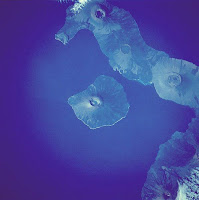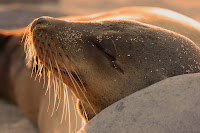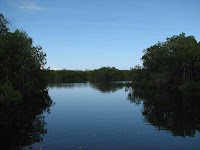 |
Fernandina on the Left; Isabela on the Right
Photograph From WikiCommons |
 |
| Fernandina's Core Erupting in 2009 from Nasa Image |
The youngest of the Galapagos Islands, at just about 1,000,000 years old, Fernandina remains on the hot spot that created all of the islands. It is considered to be an active shield volcano with a large caldera, although the caldera collapsed in 1968. Fernandina is the westernmost and third largest of the Galapagos Islands. It most recently erupted in 2005 and 2009. The Island's landscape is dominated by La Cumbre Volcano. The volcano's lava fields stretch all the way from the top of the volcano to the sea itself.
The Galapagos Conservancy and National Park are determined to keep Fernandina as pristine and untouched by humans and other non-endemic creatures as possible. So, although the Island is literally teeming with bird and marine life, there is only one approved visitation spot on the Island. But, it is really something special.
PUNTA ESPINOSA
 |
Punta Espinosa
Photograph from National Park Service
|
At Punta Espinosa you may be treated to a short walk around the peninsula and a longer walk to the edge of a large lava flow. Here’s how one of my guests described her reaction to Punta Espinosa:
"Nothing can prepare you for the Star-Trekian planet full of Marine Iguanas, hundreds of the things, worshipping their sun god as they await transport back to the mother ship. Just when you think you’ve seen so many sun-worshipping marine iguanas that you couldn’t possibly see any more, you round another corner and there’s another batch!"
(Thank you Cindy Procter-King for this unearthly description and for these two really great photographs. I recommend that everyone read Cindy’s entire post on this fabulous site. From there, you can read her entire blog as well.)
 |
| Photograph by Cindy Procter King |
 |
One Happy Sun Bathing Iguana
Photograph by Cindy Procter King |
The iguanas at Espinosa Point are so plentiful that my primary responsibility is to make sure no one steps on them! Seriously, they are more prolific than you can imagine. Only a picture does them justice. Not only that, they are large – really big. But, the marine iguanas sunning themselves on the rocks, paths, sand, under foot, every where you look are just one of the treasures here. (To learn about marine iguanas, take a look at
my post about land and marine iguanas that I wrote after a tourist tried to pack iguanas in his suitcase to take home with him – this is not a joke, but it is illegal and the consequences for this person were dire.)
 |
Flightless Cormorant Drying its Wings
Photographs from WikiCommons |
.jpg)
You certainly don’t want to miss the Flightless Cormorants. There are 27 known cormorant species worldwide, but the Galapagos Cormorant is the only flightless cormorant anywhere in the world. These birds once flew, but adapted to their environment and, over time, lost their flying ability – a true testament to “survival of the fittest.” They are safe on the ground without flying largely because they have no natural land-based predators. These birds swim just about 100 meters off shore into the salt water for their food, which consists primarily of squid, octopus, eel and small fish.
Coming soon, a post all about Flightless Cormorants – look for it here.
.jpg) |
Flightless Cormorant Swimming Just Below the Surface
Photograph From WikiCommons |
Espinosa Point is also the home to Galapagos Penguins, Sea Lions, Sally Lightfoot Crabs and even Galapagos Hawks. As for flora and fauna, the lava cactus is one of only a very few species able to survive in this lava rock.


Fernandina Island may have just one visitor site where you actually have the opportunity to walk around the island, but it is full memorable highlights.
MANGLE POINT
 |
| Mangle Point at Night from Wiki |
Off the eastern coast of
Fernandina is Mangle Point. a superior snorkeling and SCUBA dive site and a beautiful location for riding in a panga through a grove of mangrove trees. A hike of about 1/2 miles is possible. Whether you hike, snorkle, SCUBA or stay in your panga for a ride through the red mangrove trees, this second site of Fernandina Island is equally memorable. While you are on your ride, you are likely to see sea lions, tortoises, pelicans, rays and birds too numerous to name them all. The best description of this beautiful location was written again by Cindy Procter King. See her
whole post.
 |
Red Mangrove Swamp Root System
Photography by Cindy Procter King |
 |
| Entering a Red Mangrove Swamp |
 |
| Tortoises at Mangle Point from Wiki |
 |
| Lava Lizard at Mangle Point from Wiki |
 |
| Finch at Mangle Point from Wiki |






.jpg) You certainly don’t want to miss the Flightless Cormorants. There are 27 known cormorant species worldwide, but the Galapagos Cormorant is the only flightless cormorant anywhere in the world. These birds once flew, but adapted to their environment and, over time, lost their flying ability – a true testament to “survival of the fittest.” They are safe on the ground without flying largely because they have no natural land-based predators. These birds swim just about 100 meters off shore into the salt water for their food, which consists primarily of squid, octopus, eel and small fish. Coming soon, a post all about Flightless Cormorants – look for it here.
You certainly don’t want to miss the Flightless Cormorants. There are 27 known cormorant species worldwide, but the Galapagos Cormorant is the only flightless cormorant anywhere in the world. These birds once flew, but adapted to their environment and, over time, lost their flying ability – a true testament to “survival of the fittest.” They are safe on the ground without flying largely because they have no natural land-based predators. These birds swim just about 100 meters off shore into the salt water for their food, which consists primarily of squid, octopus, eel and small fish. Coming soon, a post all about Flightless Cormorants – look for it here..jpg)











The best way to avoid it is to use essential oils in air purifier water first. Since the water that comes out of the tap is often mineral water, the accumulation may be due to this
ReplyDelete